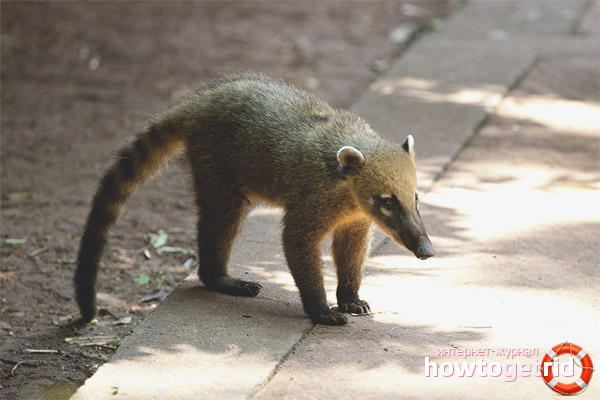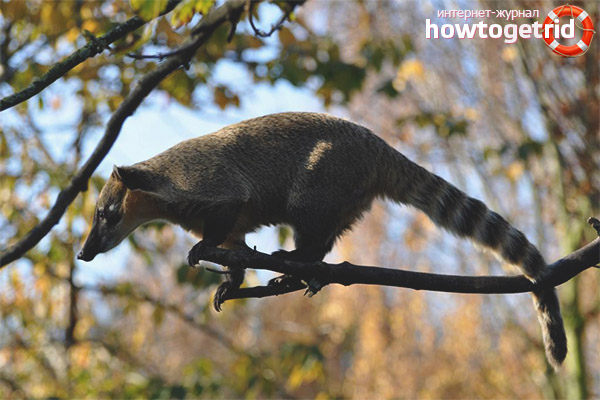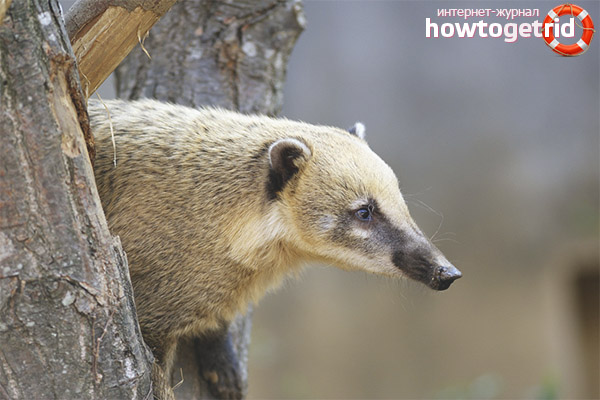The content of the article
The rhinoceros is also called coati, they belong to the representatives of the raccoon family. As the name implies, the external features of the animal have a certain zest. They have a long nose that distinguishes the nasal from the like. Individuals live preferably in Central and South America, are favorites of local residents. Animals are even kept at home as obedient and good-natured pets. But we will not immediately reveal all the cards, we will study the most important aspects in the next order.
Habitat and Description
- Coati refers to individuals belonging to the raccoon family and being mammals. They got their name due to the specific shape of the nose. It is elongated, mobile, somewhat similar to a trunk. Initially, it was the Indian tribes who nicknamed the individuals so. Then the name is firmly rooted and remains the same.
- The body of a fluffy pretty beast can vary within 40-70 cm, the tail is not included in this list. It is fluffy and elongated, grows in some individuals up to 60 cm. As for the weight category, it ranges between 8 and 11 kg. But there are also smaller representatives.
- The limbs located on the back are elongated. They are endowed with movable ankles, so the coati can go down the trees upside down without feeling discomfort. On the paws are long claws, which are necessary in order to crawl onto obstacles and trees. Claws also use claws for food and food in the soil.
- The head is small when compared with the body as a whole. It is wedge-shaped, there are protruding ears and a rounded crown. Pigmentation of the body is reddish-brown, reddish-black or reddish-gray. On the tail there are distinct strips, alternating between each other in dark and light colors. Individuals are common, as mentioned earlier, in South and Central America. Some are found in North America.
- Introduced animals like living in tropical conditions. But certain species can settle in highlands and even deserts. Despite the fact that individuals are terrestrial, they swim perfectly and adapt to the aquatic environment. Coatis love to swim and do not miss the opportunity to jump into the water. Due to the presence of membranes between the fingers, individuals move quickly.
Varieties of noses
- There are several varieties of animals represented. Their preferences, way of life and other aspects directly depend on this. Nosukh is divided into ordinary, mountain and Nelson. Coati is the fourth species, which is often generalized to all members of the family.
- Ordinary noses are understood as individuals who prefer to live in a mountainous environment and can rise to a height of up to 1.8 km. They are larger than all their relatives, pigmented in a light brown tone with orange blotches.
- As for the mountain representatives, they have a fairly short tail. The body, as it were, is compressed from the sides, so it seems that the animal is flattened. The head is much smaller than that of other relatives. As can be understood from the name of the genus, individuals live high in the mountains (2-3 km.).
- Nelson’s nosha refers to members of the family who are pigmented the darkest of all. They have a distinct white blotch on the cervical spine. There are also gray marks, like gray hair, on the forelimbs and between the shoulder blades.
Lifestyle
- These members of the family prefer to stay awake during the day. They rest after sunset. Set up nests for themselves at a height, for example, on trees.They are attributed to land creatures, they move very slowly. In a minute they can overcome about 50 meters with a leisurely step.
- When danger is approaching or hunting continues, the animals move to run and jump. But they can move so quickly exclusively over short distances.
- Females take custody of their babies and settle in groups of 10–40 noses. Males have a single way of being, they wander from one place to another. However, during the mating season, each male representative returns to his female. If suddenly the male does not come into his pack, a fight develops.
- The animals presented are assigned to the raccoon family. However, their habits are completely different. Nosoha do not harm, do not show excessive aggression. Partly for this reason, people are very pleased to bring coati to their house. They are distinguished by obedience, a peace-loving character and the fact that they treat a person well. If you equip a cage / aviary at home, put a personal house in it, then the nosha will live happily ever after.
- Extremely quickly, individuals adapt to life in such conditions. They love to play, and at the same time they compare their strength with the size of the child. When they frolic, they do not scratch, but gently clasp their hands. For a pet to feel good, it needs a climbing structure, a bowl for drinking and eating, and shelter. Instead of trees they put driftwood and stairs. From time to time, the animal is released or sent with him for a walk.
Food
- Most often, animals include mainly lizards, frogs, insects, rodents, berries and fruits. Therefore, we can conclude that such individuals are omnivorous. It is noteworthy that the animals presented go in search of food in small groups.
- The animals under discussion work in concert, they will always warn each other about the danger or prey found. If they notice a predator, nosuh make a voice whistle and lift their tail vertically. With the help of a unique nasal proboscis, animals find their food. While sniffing the territory, they can smell prey at a sufficient distance.
- Nosoha can detect a potential victim on the ground or tree. Then they begin the hunt and grab the prey with long claws. It is interesting that when a nosha is discovered by any animal, it chases after it. Then the predator catches up with the prey and bites his neck. Eating food occurs in parts.
- Often animals are kept at home. In this case, it is important to properly compose a diet. Be sure to give the predator lean meat, fish, berries, fruits and eggs. Pamper the animal with cottage cheese. It is unlikely that they will refuse such a product. Remember that the water in the drinker should always be clean.
Breeding
- Predators reach puberty at the age of about 2 years. During the mating season, males engage in skirmishes and fight for the attention of the female. After the winner appears, they begin to mate with the female. After the triumph, the main male always marks the territory with a pungent odor. Other males avoid this area.
- It is noteworthy that before mating, the male begins to show signs of attention. He tries to thoroughly clean the female’s hair. The duration of the female’s pregnancy lasts about 2.5 months. Approximately half a month before the birth, the female leaves the pack and begins to equip a nest on the tree.
- Most often, about 5 cubs appear in one litter. After giving birth, after about 1 month, the female with the young returns to the flock. The whole family helps the couple in raising and raising offspring. It is interesting that babies are already 2 weeks after birth trying to get out of their homes. The female constantly catches them and makes sure that they do not fall out.
- In fact, in the wild it is very difficult to detect and see the young of the individuals in question.Females try to carefully hide cubs from prying eyes and predators. Otherwise, such animals live outside for about 12 years. Sometimes individuals live longer.
Should I have a nose?
- It is noteworthy that individuals quickly become accustomed to captive conditions. However, do not forget that this is still a wild animal. Therefore, if an individual is acquired not in the nursery, but is captured, it will be difficult to tame it.
- Do not forget that any exotic animal can cause a lot of problems. First of all, make sure that the city has such a veterinarian. For the rest, consider a number of certain factors. Learn all the subtleties of the content of this predator.
- The view in size is approximately like a small dog. Be sure to allocate enough space at home to make the animal feel comfortable. It is worth noting that such individuals make quite unusual sounds. They are loud and somewhat like bird tweets. Not everyone can tolerate such exclamations.
- Be sure to accustom the animal to a leash, be careful and careful when walking. A nosha can behave unpredictably with other animals. Do not release the predator, it is used to the will and can safely escape. In addition to this, the coati cannot be accustomed to the tray. This is also worth preparing. Have to clean often.
- The considered individuals have rather long claws. Therefore, predators can often scratch interior items. Be careful yourself, the animal can accidentally hurt you. Not always such predators normally take root at home. Be prepared for this. In which case the individual will have to be returned to the nursery.
Nosoha protected by law, listed in the Red Book. In places of distribution, there are prohibitions on the export of these individuals beyond their habitat. For example, in Honduras. There, for violating the rules, they are imprisoned or an impressive fine is written.
Video: Nosua













Submit